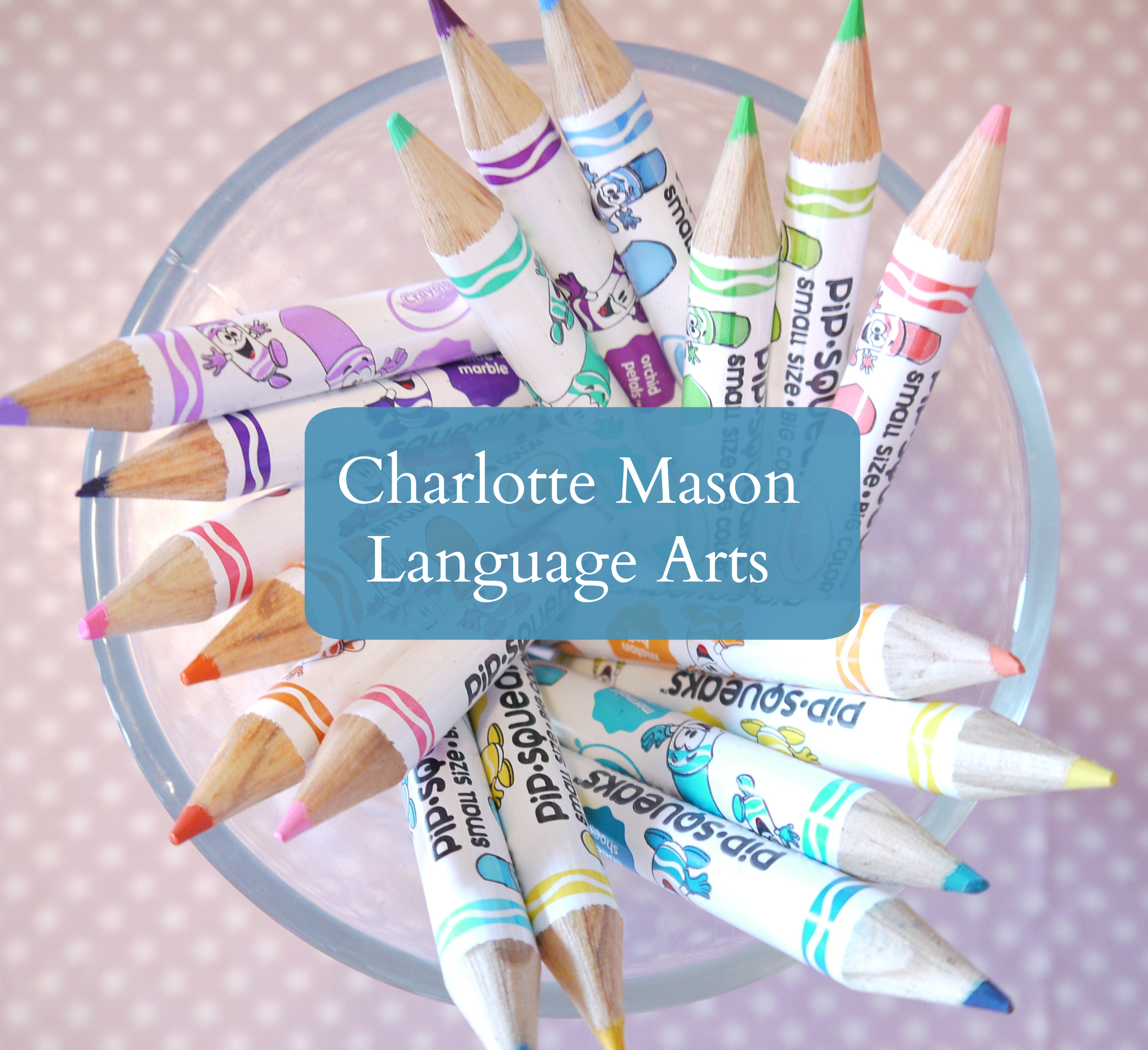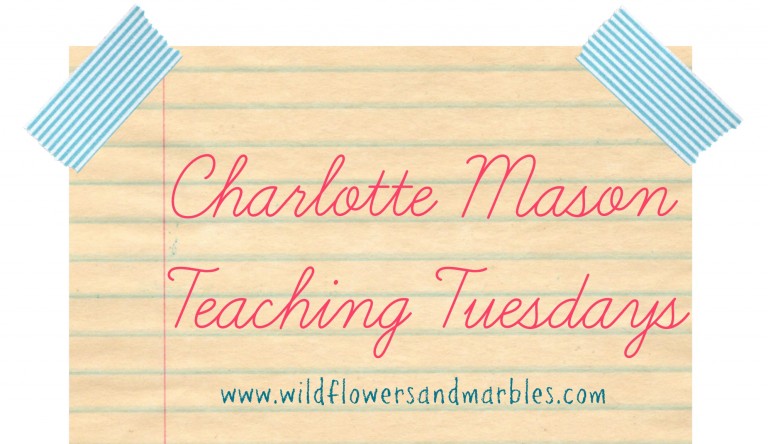Considering Language Arts – Dictation
 This is part 4 in a series considering Language Arts.So, if you’re still with me, we’ve covered a basic outline of Language Arts using Charlotte Mason methods as well as narration and copywork. Let’s talk about dictation a bit. You say, “Something else??? Another thing to put in the day?? How and where does it all fit? And, surely dictation isn’t really all that important, is it?” It is! And, I hope to convey what a useful tool dictation could be in your basket of language arts tools! I’ll wrap up all these language arts posts containing ideas and methods with a final post that has some sample lesson plans that illustrate how a week *could* look. You’ll have the methods and some ideas to help you translate this into your own days! Now, let’s get to dictation!The purpose of dictation lessons are to provide an opportunity to study a living expression (same idea as all the others…passages chosen from living books…are you getting how important it is to offer your child a feast of living books?) and make a visual memory of a word image to teach spelling. Dictation exercises are also used to introduce grammar a little at a time – don’t be intimidated though! I’ll show you how easy this can be in my next post detailing grammar!
This is part 4 in a series considering Language Arts.So, if you’re still with me, we’ve covered a basic outline of Language Arts using Charlotte Mason methods as well as narration and copywork. Let’s talk about dictation a bit. You say, “Something else??? Another thing to put in the day?? How and where does it all fit? And, surely dictation isn’t really all that important, is it?” It is! And, I hope to convey what a useful tool dictation could be in your basket of language arts tools! I’ll wrap up all these language arts posts containing ideas and methods with a final post that has some sample lesson plans that illustrate how a week *could* look. You’ll have the methods and some ideas to help you translate this into your own days! Now, let’s get to dictation!The purpose of dictation lessons are to provide an opportunity to study a living expression (same idea as all the others…passages chosen from living books…are you getting how important it is to offer your child a feast of living books?) and make a visual memory of a word image to teach spelling. Dictation exercises are also used to introduce grammar a little at a time – don’t be intimidated though! I’ll show you how easy this can be in my next post detailing grammar!
Whoa! Did I just say that spelling is taught through dictations? Yes! Do you need spelling workbooks and weekly spelling quizzes then? Nope. You don’t. Really? Does it really work? It does!!! And, as with all of these Charlotte Mason methods, dictations are chosen from a variety of choices with high literary value exposing the child to a generous breadth of thoughts and living expressions. Again, there is relationship with the lesson. Remember what Miss Mason said?
“Education is the science of relations.”
Relationship. With living thoughts and expressions. There is not a relationship in the memorization of a 10 – 20 word list. Relationships can be formed when ideas are shared.
Dictation is a tool I employ weekly for my children that write well, and with ease, usually starting around 4th grade. Letter formation should be solidly in place.
In addition to providing opportunities for learning spelling, dictation exercises provide wonderful opportunities to discuss grammar points as well as more practice with penmanship. Dictations passages are studied, dictated (read aloud by mom), and then written – all of this taking place over a period of 2 – 3 days in our home. Dictation is NOT about memorizing or speed writing, its goal is learning and executing correct spelling!
How do you choose dictation passages, and how long should it be?
Each of my children works on one prepared dictation lesson each week. Choosing a passage depends on much, and again, here’s where knowing your child’s abilities will assist you in choosing something with challenging words as well as a reasonable length for the overall selection.
In general, the length of the passage I offer is determined by the child’s writing abilities. Passages can be chosen from your child’s history reading, science reading, literature, the Bible, quotes from historical figures – any living book or noble thought. When choosing a passage, I look for a passage with a few words that are rich in terms of vocabulary and will probably be challenging in terms of spelling. (You know your child’s spelling…if there is a blend he constantly confuses, choose a passage that uses that blend in a word.)
I began choosing dictation selections from the children’s literature and history reading, and truthfully that’s all that is needed!! Again, see how simple this approach is! Invest your time and energy in selecting engaging living books for your children, and the rest falls into place.
What does a dictation lesson look like in our home?
Keep in mind that this is how I have considered and translated this method into my home. It could look different from home to home – you could spend more time on dictations, work on 2 a week, etc. This is just how it looks here.
Day 1: Give the child a passage to study. (See the grammar post for a dialogue example of a studied dictation lesson). Type it out, print it, or copy it. I ask the child to read it aloud to me. I correct any mispronounced words, or point out any times when the child went sailing over punctuation in their reading. Now it’s time for:
Studying challenging words within the dictation:
I ask the child to identify any words that look like they will be difficult to spell. I have the child underline those words on the paper. I go to the dry-erase board and write the word(s) nice and big and we discuss the spelling of that word – is there a silent letter? double consonants? a vowel team (ai, ae, ea, etc.)? Now, I ask them to look at the word and pretend that their eyes are a camera….study the word until your eyes can take a picture of the word spelled correctly and you can close your eyes and still see it in your mind. This may take a couple of days, and that’s ok! Study and make a picture image of the word or words. For auditory learners, spell the word aloud. For hands on learners, use a moveable alphabet (also consider a print your own version), write the word on paper, or draw it in the air with a finger – but be careful – the child must see, spell, write the word spelled correctly!!!!! Don’t allow a mis-spelled version of the word to enter their memory!
I have the child read the passage aloud one more time, and that’s it for day 1. This whole lesson takes between 5 and 15 minutes depending on the length of the passage and the number of words requiring study.
Day 2: I ask the child if they’re ready to write the dictation. No? Work on studying the word again (repeat above process). Yes? Dictate.
How to dictate a passage:
The child should be comfortably seated with pencil and paper. I sit nearby, within arms reach (you’ll see why in a minute), and dictate, one section at a time, pausing naturally at commas or other natural stops, giving the child enough time to write in between my reading sections aloud. This is not a speed writing contest so I only say aloud enough that the child can reasonably remember and write. My kids know to give me a simple sign to continue reading, either a nod of the head or a finger wave, so they don’t look up and lose their place. I say the passage ONLY ONCE! No repeats! Quickly cover any mis-spelled words. I like to sit near the child and use white-out correction tape (in the pen form is easiest for me to use) and just gently reach in and white-out out the word so that is not able to be seen. Some people use little post-it notes to cover a word and I wanted to make that work so much, but I haven’t been able to…so, I just use white-out. I have one child that I have to be very careful with because any interruption completely disrupts his concentration. I gently and quietly slide my finger on top of the mis-spelled word and then we use white-out. The point is to completely cover a word if it is misspelled so that the child does not make a visual memory of the misspelled word. If the child mis-spelled any words we go through the “study challenging words” process again. The child then writes the correct spelling on top of the white-out.
We might take a few minutes on Day 1 or Day 2 to discuss something grammatical/mechanical about the sentence or passage in the dictation exercise. This would be age/grade appropriate, and very simply done! My next post will detail how I approach grammar along with my favorite grammar resources. I thought about including grammar with the dictation post because in our days, we approach grammar very simply through our dictation exercises. But…sheesh…I’ve already gone on so much!!!! LOL!!!! About dictation for goodness sake!!!! LOL!!!! So, grammar will be next in the series, but please remember that most grammar is integrated with the simple and short dictation exercise.
Day 3: Optional day – If the child wasn’t ready to write on Day 2, ask the child if they’re ready to write the dictation. My kids usually only need 2 – 3 days to study a word and know it so we rarely need more than 3 days to complete a dictation exercise. But, this could vary from family to family and child to child.
Some children are natural spellers, some are not. Do NOT make dictations a competition between children. Invariably, there will be differences in ability or familiarity or both in children within a family. I do not point out differences between the dictation lessons in my home.
Editing this post to add some examples of dictations. A few people have asked for more concrete examples of what a dictation might look like. Hopefully these will help. These are dictations from this week:
9th grade – good writer, good narrator, dyslexic {yes, dyslexic! We conquered dyslexic tendencies in spelling by using…the dictation lesson…over and over again!}
From: Secrets of the Woods by William Joseph Long
I would only suggest that perhaps the real reason why we see so little in the woods is the way we go through them – talking, laughing, rustling, smashing twigs, disturbing the peace of the solitudes by what must seem strange and uncouth noises to the little wild creatures. They, on the other hand, slip noiseless feet through their native coverts, shy silent, listening, more concerned to hear than to be heard, loving the silence, hating noise and fearing it, as they fear and hate their natural enemies.
We would not feel comfortable if a big barbarian came into our quiet home, broke the door down, whacked his war-club on the furniture, and whooped his battle yell. We could hardly be natural under the circumstances. Our true dispositions would hide themselves. We might even vacate the house bodily. Just so Wood Folk. Only as you copy their ways can you expect to share their life and their secrets. And it is astonishing how little the shyest of them fears you, if you but keep silence and avoid all excitement, even of feeling; for they understand your feeling quite as much as your action.
Spelling words underlined and in red (so they stand out for you here), grammatically we discussed the dash and words in a list.
From: Trust the Creator by Ralph Waldo Emerson
All I have seen teaches me to trust the Creator for all I have not seen.
Spelling words underlined, grammatically we discussed capitalizing proper nouns.
THE fruits in using studied dictation lessons to introduce grammar and reinforce good spelling is this:
–> Expect to see fruit over the long haul!
–> Plug away at this, every day, every week, every term, every year – over the long haul!
Tools and resources:
The following are a couple of tools that have become such a tremendous help for me in offering good dictations and helping me focus on particular trouble spots in spelling:
- Spelling Wisdom from Simply Charlotte Mason, compiled by Sonya Shafer – This is an extraordinary resource!! It is a compilation of the 6000 most frequently used words in the English language, incorporated and used in a variety of living and noble thoughts from a spectrum of significant figures and events!!! AMAZING!!!! Is your child having trouble with a particular word? Use the comprehensive index in the back of the book to look up the word and reference the dication lesson(s) wherein that word is used. If not, start at the beginning and work through a lesson or two a week! It couldn’t be simpler, and the assistance this series affords in terms of an excellent index and the use of the most frequently used words makes it a very useful and frequently chosen resource on my shelf! The books offer a simple and easy to understand explanation of how to use the book as well as how to employ dictation. Mrs. Shafer explains in the Introduction that the exercises contained in the Spelling Wisdom series cover a “broad range of subjects and topics to reinforce Charlotte’s love of a full and generous education.” There are multiple grade levels available for different ages, and for those of you overseas, I LOVE that this resource can be purchased as a pdf so there is no impediment in shipping for you!
- The ABC’s and All Their Tricks: The Complete Reference Book of Phonics and Spelling
by Margaret Bishop – this is a relatively new reference for us, but I really enjoy having it around! It’s super helpful for the child who has learned to read and finished phonics lessons, but could use some review, and there’s a great section in the appendix on remedial reading as well as a super helpful appendix on syllabication. It’s a fantastic comprehensive reference for all-things-phonics-and-spelling! The bulk of the book (228 pages) is an alphabetized listing of letters (one per page) with each page containing rules and exceptions – so helpful!!! If you’re a homeschooler and have been at this for any amount of time, you have experienced a moment when your child phonetically pronounces a word, but doesn’t use the true pronunciation (which isn’t phonetic at all…sigh). An example: the word heir could sound like “hair” rhyming with “their” if you were phonetically pronouncing it, but there are many exceptions to pronouncing EI. For example, if your child answered a confirmation catechism question with “hairs of heaven” you would have to supress snorts of laughter and pull out this book and explain from p. 148 that heir is borrowed from the French, and French words usually have a silent h when it is a beginning letter. It’s a good reference packed with helpful info for the why-of-it-all!
I sure hope I’ve offered you a glimpse at how simple and effective dictation lessons can be! Free yourself and your child from a spelling workbook and spread out your spelling lessons as a rich feast of ideas before your child. You’re wondering if it works – it does! And it’s simple and beautiful in addition to being effective. Take a deep breath, and a step out in faith!
For more information on dictation take a look at the articles available at Charlotte Mason Help – Dictation, as well as this helpful video how-to available at Simply Charlotte Mason.
Stay with me, we’re talking grammar next!





These posts are so great! You mentioned before that your son doesn't like to read, I'm wondering if you do dictation like this with him or if you do it differently (movable alphabet, etc). Thanks!
Thanks, I can now see where I need to tweak our approach, why it wasn't quite working.
Hi, Kelly!
My son DOES like to read – ALOT!!!!! It's writing that is difficult. However, he writes dictations exactly as I describe in this post. I do not use the moveable alphabet. I would not start dictations UNLESS AND UNTIL a child was writing, which is why I mention that dictations don't begin until 4th grade-ish.
I edited this post to add an example of dictations for the children. Hopefully that gives a bit more of a concrete idea of dictation selections here.
Hi Jen! Thanks for the response. I meant to put write, don't know why I put read…distracted I guess 😉
Thank you so very much for these posts! They are GREATLY appreciated! Keep up the good work, and may God bless you for sharing your knowledge and wisdom.
Hello 🙂
I have just one question; I see the principle about not letting the child get a memory of misspelled words stressed SO much in C.M, and to a certain degree I can follow the line of thought. This excludes using certain types of exercices of course, which is easy enough to avoid, if one wants to apply C.M method…but, what about all the creative writing a child just does on his/her own? Like writing a little story to illustrate a drawing, writing a letter to a friend or even making small posters for use in play (like a grocery list or a menu card for playing restaurant)? My daughter for instance does these things ALL the time, and I don't sit down to create each and everyone of those with her – hence they are full of misspelled words 🙂 What do you think about that and how do you approach that in your house? Do you supervise every writing that gets done or do these kind of misspellings not matter so much, maybe because they are not made during “formal” instruction time? Just wondering…
Cheers,
Mette
Thanks so much for your question, Mette! Let me give it a try!
You asked:
>> what about all the creative writing a child just does on his/her own? ::: Do you supervise every writing that gets done or do these kind of misspellings not matter so much, maybe because they are not made during “formal” instruction time? << Great question!!!! I have kids that LOVE to write…everywhere and everything. You're right. You can't catch every spelling mistake, and I don't try. I'm just thrilled they enjoy writing, and I don't want to discourage that! I approach their free-writing a couple of ways: ** If they're expressing themselves through creative writing of some kind I think that's great! I don't correct them or their mis-spellings. I DO (discreetly) make note of words frequently mis-spelled and work to incorporate those words into dictation lessons (if the child is old enough to be doing dictation lessons…if not, I leave it alone). ** If they are writing a letter, or an article for submission somewhere, we walk it through the editing process together. I do help them correct mis-spellings at that time. Hope this helps! In short, I'm only super vigilant about mis-spellings during dictation times because the child is engaged visually, kinesthetically, and auditorily in making a mental IMAGE of a word. Since all their senses are totally engaged, I don't want the wrong spelling plugging itself in! Sure hope that makes sense!
These posts are so wonderful. They are getting me back in school-mode full of inspiration and ideas. Your blog is so helpful. Thanks for all the time it must have taken to put this series together. Blessings.
Hi Jen,
thanks for your reply. This is what I thought (making a distinction between formal dictation times and other) you're right – we do absolutely not want to “crush” our childrens' love of writing when they have it!
I have been homeschooling for a few years, but until now, rather in a very *radical unschooling* way, and have only recently begun to put down more structure to it all. Mostly because with each addition of a new child, the need for structure has just become more pressing, lol (I have 3 children now, expecting another this fall 🙂
I have been reading about C.M for a while though, and already used some of her ideas (like narration & nature walks) but I am going to try to be a little more systematic about it this year, and see how it works. I am going to start dictations and copywork ( with my oldest (dd 10 yo) and picture study with both dd and ds (5yo). Your blog is a great inspiration, thanks!
Cheers,
Mette
Thank you so very much!